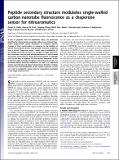Peptide Secondary Structure Modulates Single-Walled Carbon Nanotube Fluorescence as a Chaperone Sensor for Nitroaromatics
Author(s)
Heller, Daniel A.; Pratt, George W.; Nair, Nitish; Hansborough, Adam J.; Boghossian, Ardemis A.; Reuel, Nigel Forest; Barone, Paul W.; Strano, Michael S.; Zhang, Jingqing, Ph. D. Massachusetts Institute of Technology; ... Show more Show less
DownloadStrano-2011-May-Peptide Secondary Structure Modulates Single-Walled Carbon Nanotube Fluorescence as a Chaperone Sensor for Nitroaromatics.pdf (1.666Mb)
PUBLISHER_POLICY
Publisher Policy
Article is made available in accordance with the publisher's policy and may be subject to US copyright law. Please refer to the publisher's site for terms of use.
Terms of use
Metadata
Show full item recordAbstract
A class of peptides from the bombolitin family, not previously identified for nitroaromatic recognition, allows near-infrared fluorescent single-walled carbon nanotubes to transduce specific changes in their conformation. In response to the binding of specific nitroaromatic species, such peptide–nanotube complexes form a virtual “chaperone sensor,” which reports modulation of the peptide secondary structure via changes in single-walled carbon nanotubes, near-infrared photoluminescence. A split-channel microscope constructed to image quantized spectral wavelength shifts in real time, in response to nitroaromatic adsorption, results in the first single-nanotube imaging of solvatochromic events. The described indirect detection mechanism, as well as an additional exciton quenching-based optical nitroaromatic detection method, illustrate that functionalization of the carbon nanotube surface can result in completely unique sites for recognition, resolvable at the single-molecule level.
Date issued
2011-05Department
Massachusetts Institute of Technology. Department of Chemical Engineering; Massachusetts Institute of Technology. Department of Electrical Engineering and Computer Science; Koch Institute for Integrative Cancer Research at MITJournal
Proceedings of the National Academy of Sciences of the United States of America
Publisher
National Academy of Sciences (U.S.)
Citation
Heller, D. A. et al. “Peptide secondary structure modulates single-walled carbon nanotube fluorescence as a chaperone sensor for nitroaromatics.” Proceedings of the National Academy of Sciences 108.21 (2011): 8544-8549.
Version: Final published version
ISSN
0027-8424
1091-6490